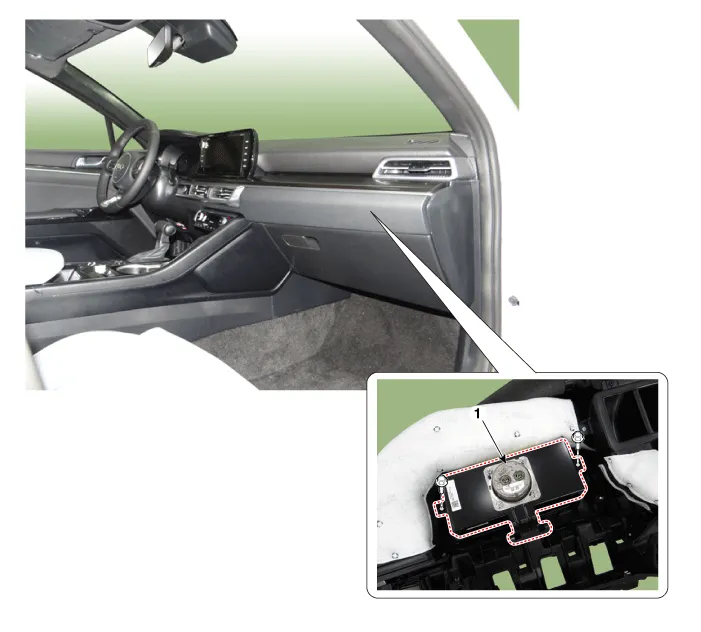Kia Optima DL3: Airbag Module / Passenger Airbag (PAB) Module
Description and operation
| Description |
The passenger airbag (PAB) is installed inside the crash pad and protects the front passenger in the event of a frontal crash. The SRSCM determines if and when to deploy the PAB.
|
Components and components location
| Components Location |

| 1. Passenger airbag (PAB) |
Repair procedures
| Inspection |
Never attempt to measure the circuit resistance of the airbag module (squib) even if you are using the specified tester. If the circuit resistance is measured with a tester, accidental airbag deployment will result in serious personal injury. |
| 1. |
Inspect the airbag according to troubleshooting table. (Refer to Passenger Airbag Module - "Troubleshooting") |
| Removal |
If the passenger airbag module has been deployed, replace the damaged crash pad. |
| 1. |
Remove the main crash pad assembly. (Refer to Body - "Main Crash Pad Assembly") |
| 2. |
Remove the passenger airbag module (A) after loosening the bolts.
|
| Installation |
| 1. |
Install in the reverse order of removal. |
| 2. |
After installing the airbag module, confirm proper system operation: Switch "ON" the ignition. The SRS indicator light should turn on for about six seconds and then off. |
Troubleshooting
| Troubleshooting |

Description and operation Description The Driver Airbag (DAB) is installed in the steering wheel and electrically connected to SRSCM via the clock spring.
Description and operation Description The Side Airbags (SAB) are installed inside the front seat and protects the driver and passenger from danger when a side crash occurs.
Other information:
Kia Optima DL3 2019-2025 Service and Repair Manual: Power Window Motor
Schematic diagrams Circuit Diagram [Safety Window Motor] [Standard Window Motor] Repair procedures Inspection Front Power Window Motor 1. Disconnect the negative battery terminal. 2.
Kia Optima DL3 2019-2025 Service and Repair Manual: Air Conditioning System
General safety information and caution Instructions (R-134a) When Handling Refrigerant 1. R-134a liquid refrigerant is highly volatile. A drop on the skin of your hand could result in localized frostbite. When handling the refrigerant, be sure to wear gloves.
Categories
- Manuals Home
- Kia Optima Owners Manual
- Kia Optima Service Manual
- Cooling System
- Emission Control System
- Power Train
- New on site
- Most important about car



